Torres Novas | |
|---|---|
.jpg.webp) .JPG.webp) .jpg.webp)   _(cropped).jpg.webp) | |
 Flag  Coat of arms | |
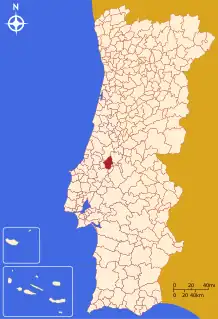 | |
| Coordinates: 39°28′N 8°32′W / 39.467°N 8.533°W | |
| Country | |
| Region | Centro |
| Intermunic. comm. | Médio Tejo |
| District | Santarém |
| Parishes | 17 |
| Government | |
| • President | Pedro Ferreira (PS) |
| Area | |
| • Total | 270.00 km2 (104.25 sq mi) |
| Population (2011) | |
| • Total | 36,717 |
| • Density | 140/km2 (350/sq mi) |
| Time zone | UTC±00:00 (WET) |
| • Summer (DST) | UTC+01:00 (WEST) |
| Local holiday | Ascension Day |
| Website | http://www.cm-torresnovas.pt |
Torres Novas (Portuguese pronunciation: [ˈtoʁɨʒ ˈnɔvɐʃ] ⓘ) is a Portuguese municipality in the district of Santarém, in the Médio Tejo of the Centro region. The population of the municipality was approximately 36,717 (from the 2011 census), in an area that encompasses 270 square kilometres (100 sq mi).[1] The city of Torres Novas proper (seat of the municipality) has about 15,000 inhabitants in an area located within the municipality.[2]
History

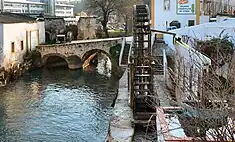
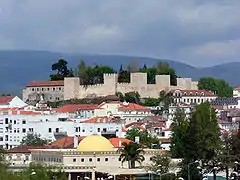
Pre-Monarchy
The earliest sign of human life in the Portuguese territory is the 400,000 year old skull discovered at the Cave of Aroeira in 2017.[3]
The territory of Torres Novas was settled as early as the Paelothic in areas situated along the margins of the karstic network of the River Almonda, such as the grottos in Buraca da Moura, Buraca da Oliveira and Lapa da Bugalheira.[4]
During the primordial period before Roman occupation, there were various villae that were populated in the region. Vila Cardílio, a Luso-Roman settlement was occupied in the first or second century A.D.[4] In it, archaeologists discovered coloured mosaics, coins, sculptures and Latin inscriptions, where one was inscribed with felicitous remarks to the villa da torre (town of the tower), an expression associated with the plausible origin for the toponymy Torres Novas.[4] Remains of Roman roads can be found north and south of Torres Novas, the latter is thought to be a part of the Olisipo-Bracara Augusta via.[5]
Monarchy
During the 12th century, the territory that was known as Turris began to develop into its actual limits, with the expulsion of the ruling Muslims by forces loyal to Afonso I of Portugal in 1148.[4] The foundation of the municipality was attributed to the foral issued on 1 October 1190, by King Sancho.[4]
While the first origins of the castle are currently unknown, it is known that Sancho I had ordered the construction of a fortification that was later destroyed during wars with Castille.[6] Later, King Fernando would reconstruct the castle with the same aim as his predecessor.[6] The most important features of the Castle date from this latter intervention.[6]
During the Middle Ages, the territory grew demographically and economically, receiving a Carta de Feira (authorizing a fair for this market) in 1263.[4]
The lands of Torres Novas passed into the possessions of Queen Isabel of Aragon in 1304 (who was transferred into her title by King Denis).[4] In the following years, Torres Novas was a meeting point for sessions of the Cortes, and historical points in the kingdoms history, like the wedding between Infanta Beatriz and Infante Henrique, children of King Fernando I and King João I of Castilo (in 1380); the establishment of regency of Queen Leonor of Aragon Aragon (due to the death of King Edward I), during the reign of Afonso V (1438); and the decisions of the Cortes, which gathered intermittently in Torres Novas, to manage the Kingdom's issues (1525).[4]
Isabel of Avis was the donatário at the first half of the 15th century, receiving a new foral, during the reign of Manuel I of Portugal (1510).[4]
In the following decade, John of Lancaster was given the title of the first Marquis of Torres Novas, along with the Duke of Aveiro (which were both extinguished in 1759, following the attempted regicide of Joseph I, associated with José Mascarenhas da Silva e Lencastre).[4] The monarch survived the attempted assassination.
In 1755, the Lisbon earthquake reached Torres Novas and destroyed four of the Castle's towers.[6]
The king's daughter later conceded a license to Henrique Meuron and David Suabe to install Fábrica das Chitas (1783), which was later destroyed by General Massena, during the third French campaign along the Iberian peninsula (1810).[4]
The economy within Torres Novas continued along the 19th century, with some successes and failures: the founding of the Fábrica de Papel do Almonda (1818); establishment of the Companhia de Fiação de Torres Novas (1845); the creation of the transporter João Clara & Companhia (Irmãos) Lda. which, at the time of its nationalization (1975), was dominated by Clara Transportes - S.A.R.L..[4] In 1835, Queen Maria I of Portugal would donate the Castle to Torres Nova's municipality, which would decide to demolish parts of the structure.[6]
The inauguration of the rail link between Torres Novas and Alcanena occurred in 1893, and was one of the most curious episode in the business and troubled history of the area. It was shut down only three years after its inauguration, due to multiple derailments earned it the nickname "Blind rat".[4]
In 1910, before the 5 October 1910 revolution, the Torres Novas castle received the status of National Monument.[6]
Post-Monarchy
Between 1940 and 1960 the Direção-Geral dos Edifícios e Monumentos Nacionais would order the reconstruction of part of the castle walls, including the towers.[6]
In 1985, Torres Novas was elevated to the status of city.[4]
On 1 January 1986, Portugal would join the European Economic Community, which would see to the construction of highway A23 leading to Spain.[5] This development benefited Torres Novas, giving it a logistical advantage and pushing the development of business and shops between the Torres Novas city center and the A23 entry.[5]
Geography
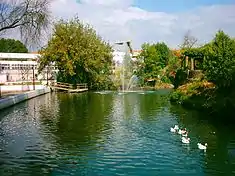

Physical geography
The municipality of Torres Novas is situated in the Médio Tejo subregion.[5] It has close regional relationships with Tomar, Abrantes, Entroncamento, Vila Nova da Barquinha, Alcanena and Ourém.[5] The castle and old town developed partially encircled by the Almonda river, which constituted a natural line of defense.[5] The soil is mostly characterized by alluviums and limestone.[5]
Climate
Torres Novas experiences a microclimate characterized by low temperature and humidity during the winter and dry air/higher temperatures during the summer due to its proximity with the mountain ranges of Aire and Candeeiros.[5] Its annual rainfall tends to be between 600 and 800mm and experiences 2400–2700 hours of direct sunlight exposure per year.[5]
Civil Parishes
Administratively, The city of Torres Novas is the seat of the municipality, that is divided into 10 civil parishes civil parishes:[7]
- Assentiz
- Brogueira, Parceiros de Igreja e Alcorochel
- Chancelaria
- Meia Via
- Olaia e Paço
- Pedrógão
- Riachos
- Torres Novas (São Pedro), Lapas e Ribeira Branca
- Torres Novas (Santa Maria, Salvador e Santiago)
- Zibreira
Four of the parishes were included in the city of Torres Novas. The union of Torres Novas (São Pedro), Lapas e Ribeira Branca concentrates the majority of the people of the municipality (over 8400 inhabitants), in contrast with the parish of Zibreira (with approximately 1000 people).[8] The largest parish, with an area of 40 square kilometres (15 sq mi), is the Torres Novas (Santa Maria, Salvador e Santiago), and the smallest is the parish of Meia Via, 4 square kilometres (1.5 sq mi).[8] The small size means that it is the largest by density, with 395 inhabitants per kilometre square, and eight times the density of the smallest, Chancelaria.[8]
Demographics
According to the 2011 census, Torres Novas had a populational density of 136 people/km2 in 2011, above the national average of 114.5 people/km2, an aging index (ratio of people ≥65 to people ≤14) of 173.0, also above the national average of 127.8, and a sex ratio of 91.2, slightly below the national average of 91.5.[9]
| Year | 1864 | 1890 | 1911 | 2009 | 2010 | 2011 | 2012 | 2013 | 2014 | 2015 | 2016 | 2017 | 2018 | 2019 |
|---|---|---|---|---|---|---|---|---|---|---|---|---|---|---|
| Average resident population | 23282 | 30041 | 41432 | 36876 | 36825 | 36701 | 36464 | 36926 | 35897 | 35663 | 35504 | 35314 | 35089 | 34952 |
| Note: 21st century data from,[9] older from.[5] | ||||||||||||||
Archeology

The oldest trace of human history in Portugal
The village of Almonda within the parish of Zibreira is noted for the Aroeira cave where the 400,000 years old Aroeira 3 skull of Homo Heidelbergensis was discovered in 2014 - the oldest trace of human history in Portugal.[3][10][11][12]
International Relations
Twin towns — Sister cities
Torres Novas is twinned with:[13]
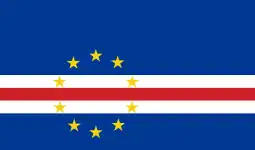 Ribeira Grande, Cape Verde, since 1997
Ribeira Grande, Cape Verde, since 1997 Moreni, Romania
Moreni, Romania Rambouillet, France, since 2010
Rambouillet, France, since 2010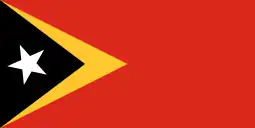 Manatuto, East Timor, since 2002
Manatuto, East Timor, since 2002
Politics
The present president of the municipality is Pedro Ferreira, elected by the Socialist Party.
City hall
| Data | % | V | % | V | % | V | % | V | % | V | % | V | % | V | % | V | Turnout |
|---|---|---|---|---|---|---|---|---|---|---|---|---|---|---|---|---|---|
| PS | PPD/PSD | CDU | FEPU | APU | AD | BE | Others | ||||||||||
| 1976 | 37.55 | 3 | 28.66 | 2 | FEPU | 23.09 | 2 | 5.36 | 0 | 61.0% | |||||||
| 1979 | 26.93 | 2 | AD | APU | 23.76 | 2 | 42.24 | 3 | 3.92 | 0 | 68.6% | ||||||
| 1982 | 30.25 | 2 | 23.05 | 2 | 40.38 | 3 | 1.87 | 0 | 65.5% | ||||||||
| 1985 | 23.26 | 2 | 36.53 | 3 | 19.47 | 2 | 16.80 | 0 | 60.0% | ||||||||
| 1989 | 34.78 | 3 | 36.61 | 3 | 15.40 | 1 | 8.13 | 0 | 60.2% | ||||||||
| 1993 | 39.53 | 3 | 39.15 | 3 | 13.50 | 1 | 2.67 | 0 | 65.2% | ||||||||
| 1997 | 49.26 | 4 | 28.16 | 2 | 13.18 | 1 | 4.35 | 0 | 63.8% | ||||||||
| 2001 | 47.58 | 4 | 24.54 | 2 | 17.02 | 1 | 2.90 | 0 | 3.29 | 0 | 62.2% | ||||||
| 2005 | 52.72 | 5 | 20.86 | 1 | 15.20 | 1 | 4.47 | 0 | 1.60 | 0 | 62.9% | ||||||
| 2009 | 53.80 | 5 | 20.90 | 1 | 13.00 | 1 | 5.85 | 0 | 3.26 | 0 | 59.0% | ||||||
| 2013 | 48.99 | 4 | 18.81 | 1 | 17.56 | 1 | 10.87 | 1 | 3.77 | 0 | 52.5% | ||||||
| 2017 | 51.56 | 5 | 15.74 | 1 | 9.83 | 0 | 15.30 | 1 | 4.57 | 0 | 54.7% | ||||||
Economy
Renova – Fábrica de Papel do Almonda, SA, a well known paper company, is based in the municipality, as well as the Companhia de Torres Novas, a textiles company founded in 1845.
Culture
The municipal holiday is Ascension Day.
There are Municipal Museum Carlos Reis, Agricultural Museum of Riachos and Humberto Delgado Memorial House in the municipality.[14]
Notable citizens
.png.webp)
- Sebastião de Sousa Dantas Baracho, (Wiki PT) (1844-1921) military man and politician during the end of the Portuguese Monarchy and part of the Constituent Assembly during the First Portuguese Republic.[15]
- Carlos António Rodrigues dos Reis, (Wiki PT) (1863-1940) naturalistic painter.[16]
- Maria Lamas (1893-1983) writer, translator, journalist, and feminist political activist.
- Manuel António Vassalo e Silva (1899-1985) officer of the Portuguese Army and an overseas administrator. He was the 128th and last Governor-General of Portuguese India.
- Humberto Delgado (1906-1965) General of the Portuguese Air Force, diplomat and politician.
- Maria Lúcia Vassalo Namorado (1909-2000) writer, poet, journalist, teacher and social reformer, and director of the magazine Os nossos filhos (Our Children).
- Carlos Cruz (born 1942) radio and TV journalist and talk-show host involved in the Casa Pia scandal.[17]
- José Luís Borga (1964) Roman Catholic priest and Christian contemporary musician.
Sport
- José Torres (1938 - 2010) football centre forward and coach with 374 club caps and 33 for Portugal
- Luís Fernando Quintas dos Santos (born 1965) known as Quintas, a former footballer with over 320 club caps.
- Jorge Casquilha (born 1969) a former footballer with 458 club caps
- Pedro Miguel Marques da Costa Filipe (born 1980) known as Pepa, a former footballer and current manager of Vitória S.C.
References
Notes
- ↑ "Áreas das freguesias, concelhos, distritos e país". Archived from the original on 2018-11-05. Retrieved 2018-11-05.
- ↑ Instituto Nacional de Estatística
- 1 2 Phys Org, March 13, 2017, 400,000-year-old fossil human cranium is oldest ever found in Portugal
- 1 2 3 4 5 6 7 8 9 10 11 12 13 14 Câmara Municipal, ed. (2015), História (in Portuguese), Torres Novas, Portugal: Câmara Municipal de Torres Novas
- 1 2 3 4 5 6 7 8 9 10 Gonçalves dos Santos, Diana (2011). "Dialogar com um Centro Histórico: O tecido urbano de Torres Novas à luz da História da Arte" (PDF). Actas do Seminário Centros Históricos: Passado e Presente: 97–150.
- 1 2 3 4 5 6 7 "Castelo de Torres Novas". Direcção Geral do Património Cultural.
- ↑ Diário da República. "Law nr. 11-A/2013, pages 552 121-122" (PDF) (in Portuguese). Retrieved 3 August 2014.
- 1 2 3 Câmara Municipal, ed. (2015), História (in Portuguese), Torres Nova, Portugal: Câmara Municipal de Torres Novas
- 1 2 "Pordata". www.pordata.pt. Retrieved 2021-03-21.
- ↑ Joan Daura et al.: New Middle Pleistocene hominin cranium from Gruta da Aroeira (Portugal). In: Proceedings of the National Academy of Sciences (PNAS) Online pre-release of 13 March 2017.
- ↑ The primitive man from Portugal, Article from 16 March 2017 des Hamburger Abendblatt, accessed on March 22, 2017
- ↑ Crânio de 400 mil anos é o fóssil humano mais antigo descoberto em Portugal 400,000 year old skull found the oldest human fossil in Portugal, Article from 13. March 2017 he Portuguese newspaper Público, accessed on March 22, 2017
- ↑ "Geminações de Cidades e Vilas: Torres Novas". cm-santarem.pt (in Portuguese). Santarém. Retrieved 2020-07-16.
- ↑ "Património artístico e etnográfico". www.cm-torresnovas.pt (in European Portuguese). Retrieved 2017-10-12.
- ↑ "Torrejanos Ilustres do Século XIX à frente dos destinos da Nação (parte 3)" (in European Portuguese). Retrieved 2021-02-13.
- ↑ "Pintura de Carlos Reis". museu.cm-torresnovas.pt. Retrieved 2021-02-13.
- ↑ Carlos Cruz, IMDb Database retrieved 14 July 2021.
Sources
- City of Torres Novas (2006). "Fundacão de Torres Novas". Archived from the original on 2007-01-19. Retrieved 2007-01-25.
External links
- Flickr.com: Photos from Torres Novas